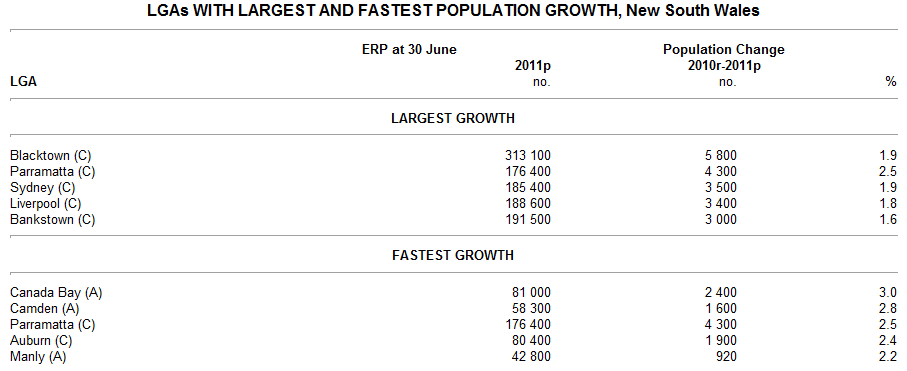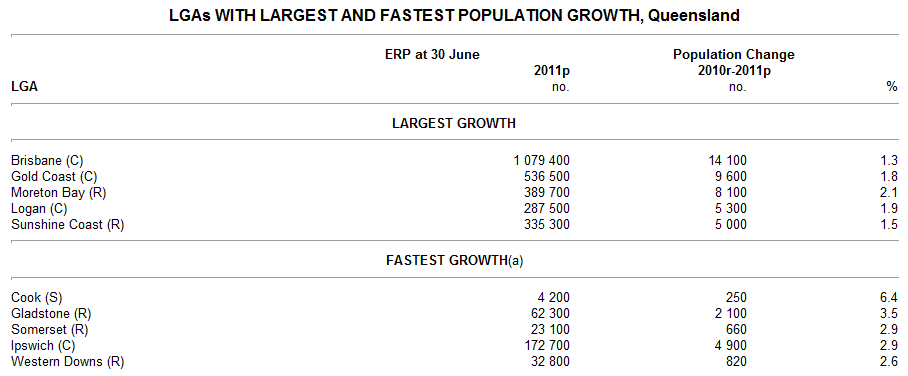If population growth is a lead indicator of impending house price growth then you'll be interested in finding out which areas have a population growth rate that's four to five times the national average. Read on to discover the country's latest population growth hotspots, as identified by the Australian Bureau of Statistics.
According to the latest ABS statistics, the Local Government Areas (LGAs) with the largest overall population changes, and the LGAs with the fastest growing populations in Australia are as follows (scroll down to see the list):


Source: ABS, Regional Population Growth, Australia, 2010-11
Read on for the LGAs with the largest and fastest population growth figures in each state or territory, as well as the ABS pick of the highlights from state and territory:
New South Wales
- Sydney SD (Statistical Division) reached 4.63 million people, an increase of 59,800 (1.3%), and continued to be the most populated capital city in Australia.
- In 2010-11, the six fastest-growing LGAs in New South Wales were all within Sydney SD, including Canada Bay (3%) in the inner west, Camden (2.8%) in the outer south-west, and Parramatta (2.5%) in central western Sydney.
- Nine of the ten fastest growing LGAs outside Sydney SD were in inland New South Wales, led by Maitland (2.1%) in the Hunter region, and Orange (2%) in central western New South Wales.

Source: ABS, Regional Population Growth, Australia, 2010-11
Victoria
- Melbourne SD's growth of 66,900 people was the largest of all the Australian capital city SDs in 2010-11.
- The largest population growth in Victoria in 2010-11 continued to occur in the outer suburban fringes of Melbourne SD. Wyndham, located to the south-west of Melbourne's city centre, had the largest growth, increasing by 12,200 people (7.8%). This was followed by Whittlesea (up 8,700 people or 5.6%), located to the north of Melbourne, and Melton (6,000 or 5.6%), to the west.
- Within regional Victoria, the LGA of Greater Geelong, located south-west of Melbourne SD, had the largest increase in population (3,300 people) in 2010-11. This was followed by Ballarat (1,900 people), in Victoria's west, and Greater Bendigo (1,500) in central Victoria.

Source: ABS, Regional Population Growth, Australia, 2010-11
Queensland
- At June 2011, the three most populous LGAs in Australia were located in south-east Queensland. They were Brisbane, Gold Coast and Moreton Bay.
- The LGA of Brisbane had the largest increase in population in Australia between June 2010 and June 2011, with an increase of 14,100 people.
- The LGAs with the fastest growth in the state were outside of south-east Queensland, with Cook growing by 6.4% and Gladstone by 3.5%.

Source: ABS, Regional Population Growth, Australia, 2010-11
South Australia
- In 2010-11, the LGAs with the largest population growth in the state were Playford, in Adelaide's northern suburbs, which increased by 2,400 people, and Onkaparinga, in Adelaide's southern suburbs, which increased by 2,000 people.
- Playford (C) was also the fastest-growing LGA in the state, increasing by 3.0%.

Source: ABS, Regional Population Growth, Australia, 2010-11
Western Australia
- Strong population growth continued in 2010-11, especially in the outer suburban fringes of Perth SD. The LGA of Wanneroo increased by 6,200 people and Rockingham by 3,900.
- South West SD was the state's fastest-growing region (3.0%), followed by Pilbara SD (2.7%) and Perth SD (2.5%).

Source: ABS, Regional Population Growth, Australia, 2010-11
Tasmania
- Latrobe (up 2.3%) in the north and Kingborough (2%) in the south were the fastest-growing LGAs in Tasmania.
- The LGAs with the largest growth were Kingborough (M) (up 680 people), Clarence (660) and Brighton (310), all within commuting distance of Hobart.

Source: ABS, Regional Population Growth, Australia, 2010-11
Northern Territory
- While Darwin SD had the slowest growth of all the Australian capital city SDs at 0.5%, it accounted for 75% of the territory's population growth, and was home to 56% of its population.
- Litchfield recorded the largest growth of all Northern Territory LGAs, increasing by 320 people.

Source: ABS, Regional Population Growth, Australia, 2010-11
Australian Capital Territory
- In 2010-11, population growth was largest in northern suburban Canberra, especially in the SLAs of Franklin (1,200 people), Forde (1,000), Bonner (920) and Casey (870).
- For the fourth year in a row, the combined population of the northern SSDs (Statistical Subdivisions) (191,700 people) was greater than that of the combined southern SSDs (173,900).

Source: ABS, Regional Population Growth, Australia, 2010-11
The big picture
Australia’s total population was found to be 22.62 million on 30 June 2011 – an increase of 320,800 in 12 months, or an annual growth rate of 1.4%. While this growth rate was lower than the five year average of 1.8%, every state and territory saw its population increase.
Victoria saw the largest population increase (84,200), followed by NSW (82,200) and Queensland (74,800). While it’s little surprise that Australia’s three most populous states recorded the highest annual population growth numbers, Queensland investors may be concerned to hear that this is only the third time in 10 years that Queensland has not had the largest growth of all states and territories.
Queensland still managed to post the third fastest population growth rate of all states and territories, however, recording a population increase of 1.7%. For the fifth year running, resources boom state Western Australia was the state or territory with the fastest growth rate (2.4%), followed by the ACT (1.9%).
Within each state and territory, the ABS noted that population growth was generally most prominent in:
- inner city areas;
- outer suburbs;
- urban infill areas; and
- along the coast.
“Areas that have seen decline include inland, rural areas that have been affected by drought in the last few years,” noted the report.
Visit the where to buy now section of our property investment forum to discuss investment hotspots with the property investment community.
More stories:
The suburbs where nobody wants to sell

